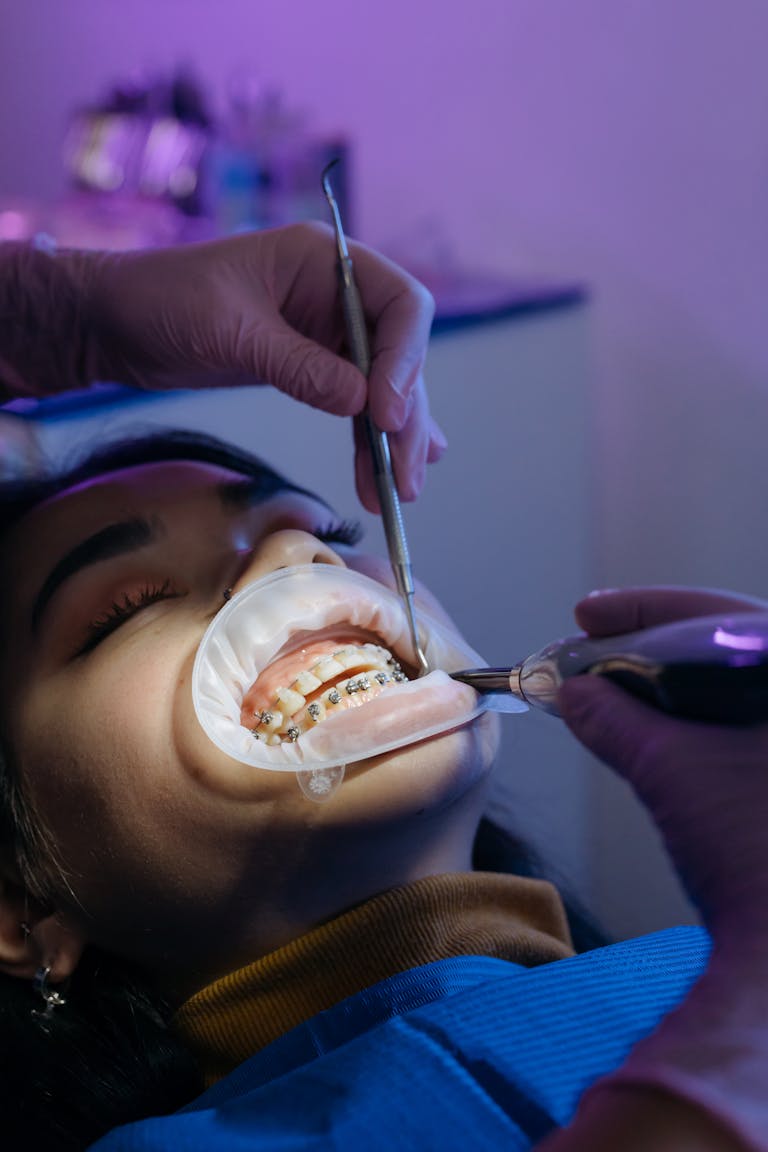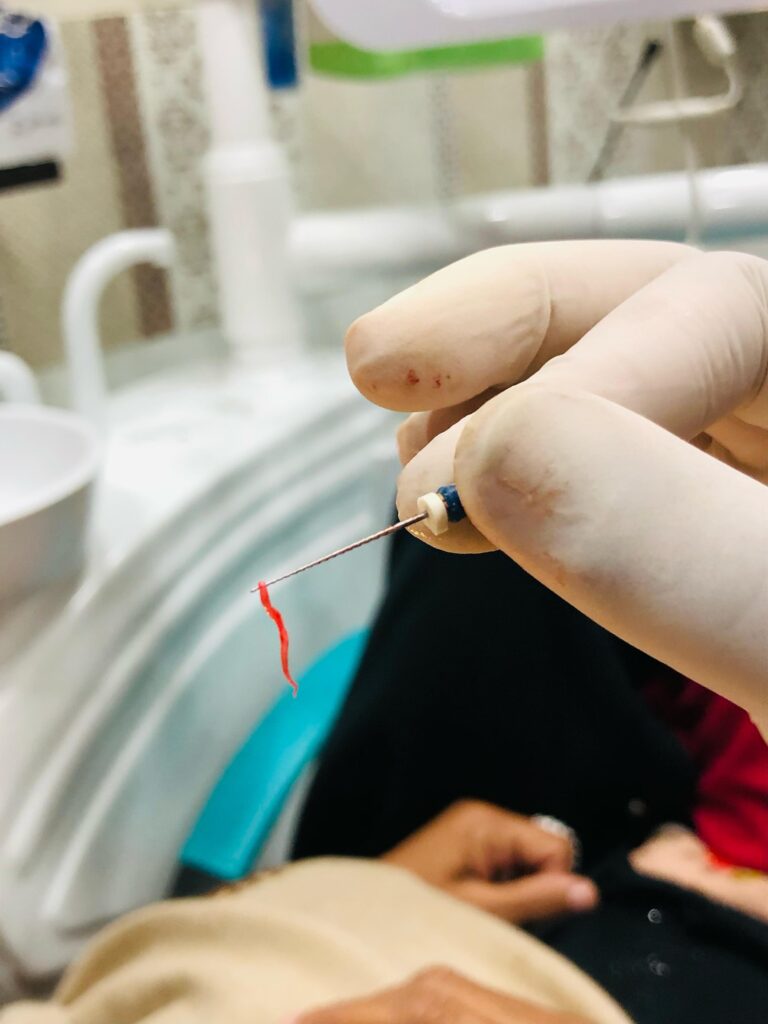Composite bonding means using tooth-colored resin to fill spaces between teeth, giving a smooth look and making gaps less clear. Dentists frequently use this for small to medium spacing, such as the diastema between maxillary incisors.
Because the resin is color-matched to blend with natural teeth, the repair is difficult to detect, and it provides a smooth surface. 98% of patients complete it in a single visit, and we rarely need to reduce teeth.
This approach is a temporary solution for some rather than orthodontia or porcelain veneers. In terms of costs and outcomes, these factors will vary depending on your location and the size of the gaps.
Below, learn more about how the composite gap closure process works, who it’s right for, and what you can expect after treatment.
Why Do Teeth Have Gaps?
Teeth gaps, or diastema, is a surprisingly common phenomenon. Gaps can form on any service area of the mouth. Perhaps their most iconic appearance is between the two top front teeth.
All these different elements combine to influence how teeth fit together and create gaps. Knowing these reasons goes a long way toward helping people understand what’s happening in their own mouths and what preventive measures will be most effective.
Genetics and Tooth Size Issues
Inherited traits are a major factor when it comes to gaps in teeth. Hereditary issues can cause some people to inherit oversized or undersized teeth, which can disrupt the natural spacing.
For instance, if teeth are undersized for the size of the jaw, spaces may appear between teeth. A larger jaw can help provide more room for your teeth. This interaction can cause real problems with tooth alignment.
Human teeth growth is highly variable from person to person. Some might come in behind schedule, as it were, while others could even have special formations that leave gaps in the smile. An extra tooth—known as a supernumerary tooth—can occasionally shift adjacent teeth, creating a space.
Missing Teeth Create Spaces
When a tooth is lost, it’s an immediate cause for a new space. Once a tooth is lost, the adjacent teeth immediately begin drifting into that space.
With enough time, this shift can lead to an even bigger gap. When a tooth that’s been lost isn’t replaced, it can throw off the entire alignment of your bite.
Taking immediate action after losing a tooth can help ensure the remaining natural teeth stay aligned.
Gum Disease Impact on Spacing
Gum disease loosens teeth by destroying the bone and tissue that anchors them in place. Once teeth begin to shift, spaces may form.
Are your gums sore or bleeding, are your gums swollen, or are your teeth getting loose? These are indications gum disease could be taking a toll.
Regular visits to the dentist can address these issues early on and even prevent new gaps from forming.
Habits Like Thumb Sucking
Thumb sucking, especially in children, can cause teeth to move outward and create spaces in the front. If the habit lingers, it will begin to affect the alignment of the teeth and can exacerbate the formation of gaps.
Other habits, such as tongue thrusting or bruxism (grinding teeth during sleep) can push teeth to create space between teeth. Identifying these behaviors and working to correct them as soon as possible can go a long way.
What Is Composite Gap Closure?

Composite gap closure is a cosmetic dental procedure that involves using tooth-colored composite resin to fill gaps between teeth. Cosmetic dentists refer to this procedure as composite bonding.
You can make big moves fast with low risk. Usually, you can walk out of the salon the same day with a totally different appearance! Composite resin closes the gap and matches the color of your teeth, so the repair is virtually imperceptible.
It’s ideal for small gaps or repairing the appearance of chipped, cracked, or even discolored teeth. In addition to being less expensive than veneers or crowns, it does not require the dentist to grind or drill down healthy tooth.
Understanding Dental Bonding Basics
Dental bonding refers to the process of applying tooth-colored composite resin to a tooth. Dentists commonly use this for small gaps between teeth, chipped teeth, or to create slight changes in tooth shape.
The resin is malleable when placed, then cured with an ultraviolet blue light. Most of the work is done right in the dental chair and it typically takes one hour or less.
The dentist pays close attention to choose a shade of resin that matches your teeth exactly. This makes sure that the line between your natural tooth and the repair is completely unseen.
When it comes to making fast, easy adjustments, bonding is a perfect go-to option.
How Bonding Fills Tooth Gaps
Initially, the dentist cleans the tooth and applies a mild acid to allow the resin to adhere to the tooth. After that, they place the resin inside the gap and form it.
Once in place, they perfect the appearance and then use a special light to cure, or harden, the resin. Finally, they smooth and polish the resin to make it blend in with the natural tooth.
When properly executed, the repair is virtually undetectable and functions as naturally as the rest of your teeth. Bonding is used to close gaps that are a few millimeters wide at the most.
Composite Resin: The Material Used
Composite resin is relatively easy to shape, and it’s available in a wide variety of shades. Maintain it and it will hold up well for 5–7 years.
Dentists love it because they can match your tooth color and fix small spots without removing healthy tooth. The resultant material is incredibly strong, though not quite as hard as natural enamel, so some subtle replacement or enhancement work may be required down the road.
Yet, for repair jobs where speed matters, it’s a highly intelligent selection.
Your Composite Bonding Journey Step-by-Step
Composite gap closure is a natural-looking dental treatment that fills gaps in teeth with tooth-colored composite resin. The procedure is gaining ground for its combination of limited invasiveness and excellent cosmetic outcome. Each step is methodical and intentional, building upon the previous to provide a truly organic, beautiful result.
Here’s what you can expect from your composite bonding appointment. We’ll take you from your initial conversation with the dentist all the way to that last buff.
1. The Initial Consultation Chat
Your initial appointment lays the groundwork for your entire bonding experience. During this meeting, the dentist listens to what you want from your smile, whether it’s closing a small gap or fixing chipped edges. You’ll discuss your cosmetic goals, so it’s best to be honest about what you would like to see improved.
At your appointment, our dentists will diligently go through your dental and medical history. They usually check your teeth and gums for signs of health and disease. They will likely want to take pictures or basic X-rays to understand the complete picture.
This thorough examination allows them to determine if composite bonding is the best option for you. Open dialogue during this step will help ensure that your composite bonding treatment plan is tailored to you, your needs, and your expectations.
As a result, in Los Angeles especially, most of our patients come to us looking for fast cosmetic procedures with little to no downtime. This initial step ensures that both parties are clearly on the same page before moving forward.
2. Picking Your Perfect Tooth Shade
It’s important to match the resin with your natural teeth for a seamless, natural appearance. Dentists pick shades with shade guides—small tabs in various tooth colors—to match against your teeth in natural light. Others go so far as to utilize digital shade-matching technology to nail it down.
Choosing a tooth color isn’t simply matching a new tooth to your existing ones. It’s about blending the filled space so it never calls attention to itself. For example, if your teeth have subtle warm or cool hints, your dentist will spot those and match the resin.
Getting your tooth shade right ensures that your new smile looks bright—but not too obviously artificial—when you’re in regular daylight.
3. Preparing Your Tooth Surface Gently
Before any resin is applied, the surface of your tooth will be prepared accordingly. This step is non-invasive and relatively fast. Your dentist will thoroughly clean your teeth at your appointment.
In addition, they will likely suggest you brush and floss thoroughly before your appointment to ensure the resin bonds properly. Next, they’ll apply an acidic gel to the surface of your tooth to make the enamel rough.
This preparation, called “etching,” allows the resin to create a strong bond. Compared to crowns or veneers, this technique preserves nearly all your natural tooth structure. That translates to fewer drillings and no shots for the majority of Americans.
The simplest way to think about the goal is to prepare the tooth while removing as little enamel as possible.
4. Applying the Composite Material Skillfully
Your dentist will apply small amounts of soft, tooth-colored resin to your affected tooth, carefully building it up directly in the gap. Once in place, they mold and sculpt it using various dental instruments, ensuring it naturally matches your other teeth and aligns properly.
This step is comparable to sculpting, and it requires a trained eye. Dentists work in layers, building up and sculpting each layer, so the resin achieves the proper contour and durability. For instance, if the space is large, additional layers will be required to securely bond.
The dentist’s artistry plays a significant role in the final appearance of the bonding — it can look quite natural or very fake.
5. Hardening the Resin with Light
Once the resin has been sculpted, it’s time to cure it to be hard, strong and resilient. The dentist uses an intense blue curing light during this step. The light causes the resin to harden in a matter of minutes, often under five per tooth.
This process, called polymerization, changes the resin from a pliable material into a hard, durable one. This step hardens the resin so it can be used while biting and chewing. Quick curing saves you a ton of time in the chair.
Many times, this means you’re able to get all the bonding done in just a single visit, which makes it ideal for busy adults living in a city like LA.
6. Shaping for a Natural Look
After curing, the dentist trims and smooths the bonded area to match the shape and size of your real teeth. They look for symmetry—they want both sides of your mouth to appear equal. Small files and diskettes assist them in obtaining the appropriate lines and curves.
After careful shaping, the results preserve the natural feel of your bite and the appearance of your smile — no bulky look here! This way, any rough spots can be smoothed away, ensuring your lips and tongue easily glide across the new surface.
7. Polishing for a Smooth Finish
Finishing touches include polishing the bonded area. Finally, the dentist will polish the bonded area to ensure it is smooth and glossy, so it reflects light the same way real enamel does.
The new resin should feel organic when it’s new, like your tongue and gums can tell that’s a good piece of composite. It stops plaque from accumulating. Polished teeth are easier to keep clean and look brighter and healthier.
Many dentists will suggest returning once a year for a quick re-polish, which helps to prevent chipping of the composite and keep your smile looking brilliant!
Your composite bonding procedure should be speedy, often completed within 30 to 60 minutes per tooth and completed in one visit. Most patients experience no side effects, although some report mild sensitivity, which usually subsides within a few days.
Continue to brush your bonded teeth twice a day to maintain their appearance. Remember to floss every day and avoid chewing on hard items such as pens or ice! With these habits, composite bonding can last from five to ten years, depending on care, where the resin is placed, and habits like teeth grinding.
Big Wins with Composite Bonding
Of all restorative options, composite bonding is a winner for gap closure because it’s fast, simple, and offers a seamless appearance. A lot of folks want quick gap closure that accommodates their time, money, and expectations for aesthetics. Composite bonding is a great option for urban patients.
As a result, it’s an excellent option in busy markets such as California’s Los Angeles County, where time and results matter most.
Quick Results, Often One Visit
The biggest selling point for most folks is that composite bonding can close gaps in only one appointment. The process is quick and simple—no drilling, no major prep required. The skilled dentist carefully molds the tooth-colored resin around the sides of the teeth adjacent to the space.
Then, they hardened it off with a special light. Immediately after, the effects are apparent, and patients leave with a transformed appearance just a few hours later. This speedy conversion saves patients time away from work with no extended periods between appointments.
With that kind of speed, it’s no surprise to hear about those kinds of satisfaction.
Generally More Affordable Option
In general, composite bonding is a more affordable option than braces or porcelain veneers. In the U.S., gap closure fees never fall below $500-$700/tooth. That’s a huge savings compared to the cost of getting veneers or doing full orthodontics.
To most, it means achieving a better smile is within reach—without breaking the bank. The resin may last as long as five to seven years, making them a great value for the cost.
Minimal Tooth Alteration Needed
With composite bonding, the natural tooth is largely left intact. There is minimal tooth alteration needed. Dentists don’t have to grind down the enamel, as they do when placing a crown or veneers.
Since the resin bonds to the existing tooth structure, it’s an extremely conservative repair. This means that it is less invasive and less prone to risk, plus easier to undo if desired.
Looks Very Natural When Done Well
When done properly, a talented dentist can make the composite resin blend seamlessly in color and gloss to the adjacent teeth. Color and shape wise, the bonded area should not be noticeable.
The resulting smooth and matte finish, in my opinion, looks very natural when done well. This provides real confidence to people without changing their smile to something that doesn’t match.
It’s Reversible If Needed
Composite bonding is a temporary solution in cosmetic dentistry, offering flexibility for patients with dental needs. Dentists can easily remove or change the resin material without damaging the tooth enamel, allowing for future updates and alternative treatments for a beautiful smile.
Things to Keep In Mind
Composite gap closure is a simple solution for gaps in your smile. It’s non-invasive like no other dental work, but you avoid the needles and drilling. You come in for a morning or afternoon appointment, and you leave with a new smile.
However, it isn’t a cut and paste solution.
Potential for Staining Over Time
Where composite resin can be stained by foods like coffee, tea, red wine, or berries, porcelain is highly resistant to staining. As opposed to natural enamel, composite stains more quickly.
To prevent them, brush twice a day with a soft brush and floss daily. Consistent professional dental cleanings help manage staining. After bonding, it’s best to be careful about what you eat.
By avoiding or limiting darker foods and beverages, you can minimize the potential stains on your smile over time.
Not as Strong as Porcelain
Not as strong as porcelain, composite is not as strong as porcelain. Porcelain veneers are a lot more resilient to chips and cracks.
If you are a nail biter or ice chewer, composite will be prone to wear more quickly. For people looking for a more lasting option, or who tend to make a lot of heavy bites, porcelain might be the way to go.
Understanding the distinction allows you to choose what’s best for your situation.
May Need Touch-Ups or Repairs
Composite breaks down with typical wear and tear—brushing, biting, or chewing harder foods. Chips and cracks may occur.
For us civilians, a touch-up is generally needed every few years, typically 5 to 7 years. Being diligent about regular maintenance care can catch issues before they develop into larger, costlier concerns.
Repairing Existing Composite Work
Just like a new composite, old composite can become worn down or crack. Yes, dentists can patch or layer new material over old, but it’s an art.
It is usually best to refresh your bonding long before checking your current bonding becomes necessary.
Is Bonding Right For You?

Whether or not composite bonding is right for you depends on these main factors. No two smiles are the same, which is why an individual plan is always the best approach. Bonding is unique in being fast—most people in Los Angeles are able to complete the bonding process in a single visit.
Costs average out to $100 to $400 per tooth, making it a more affordable option compared to braces or veneers. When done properly, the effects typically last 5-7 years. Porcelain is harder and more durable with a lifespan of 15 to 20 years. Bonding does provide most patients with an easy solution for small chips or gaps.
Assessing Your Gap Size
The size of your gap shapes your choices. For small to moderate spaces, bonding can close the gap well. It works best when the spacing isn’t too wide.
If the gap is larger, dentists might talk about braces or veneers instead. A pro checkup is key—they measure the gap and share the best path forward based on what they see.
Evaluating Your Oral Health
Strong, well-cared-for teeth and gums form the foundation for any aesthetic treatment to build on. If there are cavities, gum issues, or enamel erosion, these conditions should be treated before bonding.
So bonding bonds better and lasts longer on a good base. Your dentist should evaluate all of the following factors to ensure dental bonding is safe and wise for you.
Considering Your Lifestyle Habits
Consider your lifestyle habits. Habits will determine how long bonding lasts. Habits like smoking, consuming large amounts of soda, or neglecting to brush teeth can erode enamel quickly.
Brushing twice a day and flossing daily will keep your bonding looking good for many years to come. A soft-bristled toothbrush is recommended for optimal cleaning! These simple lifestyle adjustments can help you get the most value out of your new smile.
Matching Your Aesthetic Goals
After all, the most important thing is what you want. Some people just want a quick …
With bonding, you can collaborate with your dentist to choose color, shape, and size. A quick consult can help you figure out what you want and what’s doable with bonding.
Keep Your Bonded Smile Bright

Composite gap closure provides a quick, easy and effective solution to close small gaps and preserve more of your natural tooth. The composite resin will match your teeth and can last several years. Just like your natural teeth, the brightness of your bonded smile is largely based on your daily maintenance routines.
Developing good habits and making smart choices will take you far.
Smart Oral Hygiene Habits
Daily care is the biggest factor of all. Brushing two times a day with a soft-bristle toothbrush and flossing once a day will keep enamel-staining plaque at bay. It helps to keep the bonding smooth and clear.
Aggressive scrubbing and flossing or not flossing can prematurely age the resin or allow stains to accumulate at the margins. Being gentle on your smile takes care of your composite and makes it last longer and look better.
Routine cleanings with your dentist will take care of the plaque and tartar that brushing alone won’t get rid of. Only your dentist will be able to identify early signs of wear or damage. This lets you detect minor problems early on while you can still easily correct them.
Foods and Drinks to Watch
Certain foods and drinks can cause more staining on composite than others. Coffee, tea, red wine, and dark soda can stain enamel quickly. Other foods that can stain include berries, curry or turmeric, and tomato sauce.
Consuming these food and drinks frequently or in large quantities can stain your smile in the long run. Replacing with water, milk, or other light-colored options can prevent staining.
If you must indulge in staining foods, rinse your mouth with water afterwards to mitigate their effects. Chewing hard objects, such as ice cubes or hard candies, can chip composite, so exercise caution.
Regular Dental Check-up Importance
Regular dental check-ups, usually every six months, will ensure bonded teeth stay bright and beautiful. Your dentist will be able to catch any worn areas, developing stain, or rough margins that need to be smoothed.
These visits provide you an opportunity to communicate about what is or isn’t working with your care routine. Early detection of damage allows for a quick, painless fix and prevents your smile from looking worn out.
Other Ways to Close Gaps
There are lots of other effective options for closing gaps between teeth, other than composite bonding. The default, “best” choice is usually the one that best fits your unique situation. Decide how much you want to spend and listen to your dentist about what option is best for you.
Others choose porcelain veneers, which cover the front of the teeth to mask gaps. Some may require crowns, which cover the entire tooth and can close bigger gaps. If you’re trying to shift your teeth into alignment, braces or clear aligners such as Invisalign are the best options. They function by slowly moving your teeth through a series of months.
Some people will consider a dental implant or dental bridge if the gap is due to a lost or missing tooth. What’s going to work best truly depends on your teeth, budget, and the time you’re willing to invest.
Comparing Bonding vs Veneers
| Feature | Bonding | Veneers |
|---|---|---|
| Cost | Lower | Higher |
| Durability | 3–7 years | 10–15 years |
| Appearance | Good, may stain | Natural, resists stains |
| Suitability | Small–medium gaps | Small–medium gaps, shape/color fix |
While bonding is the quickest, least expensive option, it can stain and wear down more quickly. Veneers are more expensive but they last longer and maintain their appearance.
If your gap is tiny, bonding may be all that’s needed to fill it. If you’re looking for a more dramatic alteration in shape or shade, porcelain veneers might be the right choice for you. Personal aesthetics and functional needs will ultimately decide the best route to take.
Bonding vs Orthodontic Treatment
Bonding closes gaps quickly. Orthodontics (including braces or clear aligners) can take several months to a year or more.
Orthodontics is only for larger gaps or if teeth need repositioning. Braces and aligners are more complex and cost more.
Bonding is good for adults wanting a quick fix. Always talk to a dentist to weigh your options.
Conclusion
Composite gap closure provides an immediate and affordable solution to close small gaps and enhance the overall appearance of your smile. The process goes a long way in making it clear and straightforward. You’re typically in and out in one visit. No more needing a shot or waiting hours. The outcomes endure with some maintenance, such as brushing effectively and avoiding difficult foods. Americans select this remedy more than ever due to its tangible appearance and compatibility with fast-paced lifestyles.
Have a gap that’s been bugging you? During your next dentist visit, ask if bonding is right for you. Give it a test run, determine whether it fits your requirements. Looking for more advice or inspiring examples? Leave your comments and questions down below or contact your neighborhood dental professional to discuss. Providing a composite gap closure solution, your next smile may be nearer than expected.
Frequently Asked Questions
What is composite gap closure?
Composite gap closure is a cosmetic dentistry procedure that utilizes tooth-colored resin bonding to effectively close gaps between teeth. Dentists skillfully sculpt and harden the composite material, resulting in a beautiful smile after just one appointment.
How long does composite bonding for gaps last?
With proper oral hygiene, composite bonding for closing gaps can last anywhere from 5 to 7 years, helping to maintain a beautiful smile. Regular dental checkups at a boutique dental clinic are essential for ensuring the longevity of your treatment.
Is composite bonding painful?
Is composite bonding painful? Typically, cosmetic tooth bonding is not painful. Most patients will require no anesthesia, as the dentist only works on the tooth surface and does not drill into the tooth enamel.
Can composite bonding close large gaps?
Can composite bonding effectively close large gaps? For wider gaps or extreme spacing, your dentist might suggest orthodontic treatments or the use of composite veneers to achieve the best outcome.
How much does composite gap closure cost in the U.S.?
How much does cosmetic dentistry for closing gaps cost in the U.S.? Price varies based on geographic area and the dentist’s expertise.
Does composite bonding stain or discolor?
To maintain a bright smile and prevent issues like tooth decay, routine dental cleanings are essential, especially since composite resin can stain over the years from substances like coffee, tea, or tobacco.
Will I need to change my oral hygiene routine after bonding?
Maintain good oral hygiene by brushing and flossing, and ensure regular checkups at your boutique dental clinic. While daily oral hygiene remains crucial, avoid chewing crunchy foods on bonded teeth for optimal cosmetic dentistry results.





